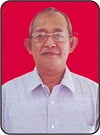Philosophical and Traditional Arts of Bugis-Makassar in Historical Perspective
Abstract
ABSTRACT: Traditional and modern, considered by many people, are two opposite things. In the context to the art, for example, many people assume that traditional art to be inferior to modern art, because modern art is considered more capable in terms of satisfying the soul or mind of society. This paper discusses the philosophy and history of traditional arts of Bugis-Makassar in South Sulawesi, Indonesia. Philosophy of art, that will be discussed, includes about ideas, meaning, experience, and intuition depicting symbolic meaning in the art of traditional of Bugis-Makassar. This paper uses literature review. Data were collected by conducting literature searches and documentation. Data has also been collected through the reading and study of literatures, and further to be discussed and analyzed to describe the philosophy and history of traditional arts of Bugis-Makassar descriptively. The results of the study showed that the art originated from pre-history and lasted until now. Art evolved into several types, namely primitive art, classic art, traditional art, modern art, and contemporary art. Traditional art is an element of art that are part of life in a specific clan, including Bugis-Makassar traditional arts which has had characteristic different from those in other areas. Traditional arts (Bugis) surviving until now include “Pajaga Makkunrai” dance and “Sinrili” (Makassar) are a form of art speech of the story, structured, rhythmic, and poetic chanted by the expert or called as “pasinrili”.
KEY WORD: Philosophy; Historical Perspective; Modern Art; Bugis-Makassar Traditional Arts; Survival.

About the Author: Haji Muhammad Bahar Akkase Teng is a Senior Lecturer at the Department History, Faculty of Humanities UNHAS (Hasanuddin University) Makassar, Jalan Perintis Kemerdekaan Km.10 Makassar, South Sulawesi, Indonesia. The author is able to be contacted via mobile phone at: +628124246613 or via e-mail at: baharakkase@gmail.com
How to cite this article? Teng, Haji Muhammad Bahar Akkase. (2016). “Philosophical and Traditional Arts of Bugis-Makassar in Historical Perspective” in TAWARIKH: International Journal for Historical Studies, Vol.8(1) October, pp.69-78. Bandung, Indonesia: Minda Masagi Press and UIN SGD Bandung, ISSN 2085-0980.
Chronicle of the article: Accepted (January 22, 2016); Revised (May 20, 2016); and Published (October 28, 2016).
Keywords
Full Text:
PDFReferences
Abel, C.R. & W.O. Hare. (1997). Hermes Trismegistus: An Investigation of the Origin of the Hermetic Writings. Sequim: Holmes Publishing Group.
Alican, N.F. (2012). Rethinking Plato: A Cartesian Quest for the Real Plato. Amsterdam and New York: Editions B.V. Rodopi.
Alican, N.F. & H. Thesleff. (2013). “Rethinking Plato's Forms” in ARCTOS: Acta Philologica Fennica, 47, pp.11-47.
Andaya, Leonard Y. (1983). “Pandangan Arung Palakka tentang Desa dan Perang Makassar, 1666-1669” in Anthony Reid & David Marr [eds]. Dari Raja Ali Haji hingga HAMKA: Indonesia dan Masa Lalunya. Jakarta: Grafiti Pers, Translation, pp.139-162,
Annas, Julia. (1981). An Introduction to Plato’s Republic. Oxford: Oxford University Press.
Batang, H.M. Sirajuddin. (2008). Sastra Makassar. Makassar: Pustaka Refleksi Makassar.
Cense, A.A. (1979). Makassar — Nederlands Woordenboek. Martinus Nijhoff: ‘s-Gravenhage.
Cohen, Matthew Isaac. (2010). Performing Otherness: Java and Bali on International Stages, 1905–1952. London: Palgrave Macmillan.
Etal, Abdul Rahim Mone. (1973). Adat dan Upacara Suku Bugis Makassar di Sulawesi Selatan. Ujung Pandang: Lembaga Sejarah dan Antropologi.
Gani, A.G. et al. (2012). Ensiklopedi Umum. Yogyakarta: Penerbit Kanisius.
Golden, Leon. (1975). “Plato's Concept of Mimesis” in British Journal of Aesthetics, 15, pp.118–131.
Hamid, Abu. (1994). Syekh Yusuf: Seorang Ulama, Sufi, dan Pejuang. Jakarta: Yayasan Obor Indonesia.
http://riyanhidayat28.wordpress.com/filsafat-seni-seni-sebagai-sesuatu-yang-kontekstual-sebuah-resensi-buku-jacob-sumardjo2000 [accessed in Makassar, Indonesia: 3 July 2016].
Hyland, Drew. (2008). Plato and the Question of Beauty. Bloomington: University of Indiana Press.
Jurriens, Edwin. (2006). Ekspresi Lokal dalam Fenomena Global: Safari Budaya dan Migrasi. Jakarta: LP3ES and KITLV-Jakarta.
Kemendiknas RI [Kementerian Pendidikan Nasional Republik Indonesia]. (2008). Kamus Bahasa Indonesia. Jakarta: Pusat Bahasa, Kementerian Pendidikan Nasional Republik Indonesia.
Kemenkominfo RI [Kementerian Komunikasi dan Informasi Republik Indonesia]. (2011). Pemetaan Media Tradisional Komunikatif: Lestarikan Tradisi Kelola Komunikasi. Jakarta: Direktorat Jenderal Informasi dan Komunikasi Publik, Kementrian Komunikasi dan Informatika Republik Indonesia.
Lindsay, Jennifer. (1991). Klasik, Kitsch, Kontemporer: Sebuah Studi tentang Seni Pertunjukan Jawa. Yogyakarta: Gadjah Mada University Press, Translation.
Mangemba, Haji Daeng. (1980). Budaya Makassar. Ujung Pandang: UNHAS [Universitas Hasanuddin] Press.
Manyambeang, Kadir. (1984). Upacara Tradisional dalam Kaitannya dengan Peristiwa Alam dan Kepercayaan di Provinsi Sulawesi Selatan. Jakarta: Depdikbud RI [Departemen Pendidikan dan Kebudayaan Republik Indonesia].
Mattulada. (1985). Latoa: Suatu Lukisan Analitis terhadap Antropologi Politik Orang Bugis. Yogyakarta: Gadjah Mada University Press.
Mattulada. (1987). “Kebudayaan Bugis-Makassar” in Koentjaraningrat [ed]. Manusia dan Kebudayaan di Indonesia. Jakarta: Penerbit Djambatan.
McQuail, Denis. (2000). Mass Communication Theory. London: Sage Publications, fourth edition.
Monoharto, Goenawan et al. (2003). Seni Tradisional Sulawesi Selatan. Makassar: Lamacca Press.
Najamuddin, Munasiah. (1982). Tari Tradisi Sulawesi Selatan. Ujung Pandang: Bakti Baru Berita Utama.
Paeni, Mukhlis. (1986). Dinamika Bugis-Makassar. Jakarta: PT Sinar Krida.
Rahim, Rahman. (1985). Nilai-nilai Utama Kebudayaan Bugis. Ujung Pandang: UNHAS [Universitas Hasanuddin] Press.
Sapada, Nurhani. (1975). Tari Kreasi Baru Sulawesi Selatan. Ujung Pandang: CV Riantira.
Soedarsono, R.M. (1998). Seni Pertunjukan Indonesia di Era Globalisasi. Jakarta: Depdikbud RI [Departemen Pendidikan dan Kebudayaan Republik Indonesia].
Soedarsono, R.M. (2003). Seni Pertunjukan dari Perspektif Politik, Sosial, dan Ekonomi. Yogyakarta: Gadjah Mada University Press.
Verdenius, Willen Jacob. (1962). Mimesis: Plato's Doctrine of Artistic Imitation and its Meaning to Us. Leiden: Brill.
Wahid, Sugira. (2008). Manusia Makassar. Makassar: Pustaka Refleksi Makassar.
Wallace, I.L. & J. Hirsh. (2011). Contemporary Art and Classical Myth. Farnham: Ashgate.
Worsley, Kris. (2015). “Smith, Rousseau, and the Sentiments of Impassioned Musical Expression: Abstract”. Available online at: http://www.gla.ac.uk/media/media_410401_en.pdf [accessed in Makassar, Indonesia: July 30, 2016].
